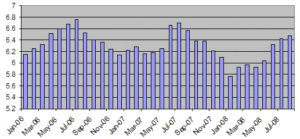Some might consider this article’s title pure hyperbole. Let me be clear: It’s not. In July of 2012, the Flood Insurance Reform Act was passed. Some of its pieces weren’t “plugged in” until recently, but because of this piece of legislation, buying a certain home now can be like playing Russian roulette. Let’s learn about Louisville flood insurance.

Here’s the inside scoop…
National Flood Insurance Program cut all flood insurance premiums
Prior to this 2012 piece of legislation becoming law, the federal government subsidized a large portion of a homeowner’s mandatory flood insurance costs. We may question why they would, given their propensity to take money rather than give money, but since 1968 we’ve enjoyed the National Flood Insurance Program (NFIP) and all of its benefits.
What this meant was that buyers who bought homes where the improvement (basically the house) was even partially located in the floodplain, were required to purchase flood insurance.
With NFIP in place, the premiums for their flood insurance were roughly half what they should have been, thanks to the government’s participation.
The average annual subsidized premium was $1,121 in 2010, discounted from the $2,500 to $2,800 that FEMA said would be required to cover the full risk of loss.
Like most government programs, NFIP is wildly inefficient and has an outstanding debt of more than $24 billion as of July 31, 2013, according to the U.S. Government Accountability Office.
Yes, that’s 10 zeroes. As we all know, the government spends money on water. *ahem*
Flood Insurance Reform Act of 2012 removed the subsidies
The government has realized the tide is rising (please forgive me), and they want to keep their heads above water (last one, I promise), thus we arrive at the aforementioned Flood Insurance Reform Act of 2012.
Now that the law has kicked in, so have the horror stories.
Rates are truly based on the risk of future flooding so even though the average increase in flood insurance rates is double, there are cases where it could be much higher.
During a recent continuing education class our instructor, real estate attorney Harry Borders of Borders & Borders, cited an example where the new flood insurance premium was 15 times the previous rate.
Which makes that property instantly less valuable and next to impossible to sell.
Another example:
Owners of older oceanfront vacation homes in places like Cape Cod report getting socked with enormous premiums. Dawn Karol, who bought a cottage in Yarmouth, Mass., in November 2012 for $450,000, was sent an initial premium notice of $65,000. [link]
If you are trying to sell a Louisville home located within the floodplain, your property may now be unsellable due to an extreme flood insurance premium.
According to Becky Hedgspeth with Epic Insurance Solutions (formerly Hayes, Utley & Hedgspeth Insurance), the flood policy premiums vary drastically and there are limits of $250,000 for home/dwelling and $100,000 for contents.
Hedgspeth provided a few real-world examples:
- Not in a high-risk area – ZIP code: 40241; $250,000 home/$100,000 contents with $1,000 deductible; 2014 premium $400
- Flood zone – ZIP code: 40207; $250,000 home/$100,000 contents with $5,000 deductible; 2013 premium $2,011 (Renewal premium not yet available but insured is very concerned.)
- High-risk flood zone – ZIP code: 40213, $125,000 home with $1,000 deductible; 2014 premium $771
- High-risk flood zone – ZIP code: 40014; $250,000 home/$100,000 contents with $5,000 deductible; 2014 premium $3,884 (increased $768 over the previous year)
“Not so fast,” says Congress
Due to the uproar, Congress is back-pedaling. On Friday, the Senate passed a bill that “calls for a four-year timeout on rate increases triggered either by a property’s sale or a flood map update for a property with previously grandfathered rates.”
The bill now goes to the House for consideration.
It’s important to note that every property is unique. Wise buyers get quality advice from both their Realtor and a professional insurance agency.
Not all floodplain properties are a bad purchase but make sure you know all the risks before signing.
If you decide to buy one of those charmers, best of luck to you, come hell or high water!



